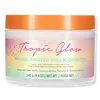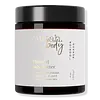What's inside
What's inside
 Key Ingredients
Key Ingredients

No key ingredients
 Benefits
Benefits

 Concerns
Concerns

 Ingredients Side-by-side
Ingredients Side-by-side

Water
Skin ConditioningGlycerin
HumectantGlyceryl Stearate
EmollientCaprylic/Capric Triglyceride
MaskingButyrospermum Parkii Butter
Skin ConditioningPEG-100 Stearate
Pistacia Vera Seed Oil
Skin ConditioningPsidium Guajava Fruit Extract
AstringentTheobroma Grandiflorum Seed Butter
Skin ConditioningCetearyl Alcohol
EmollientDimethicone
EmollientMyristyl Myristate
EmollientAcrylates/C10-30 Alkyl Acrylate Crosspolymer
Emulsion StabilisingSodium Hydroxide
BufferingSodium Chloride
MaskingDisodium EDTA
Parfum
MaskingCaprylyl Glycol
EmollientBenzyl Benzoate
AntimicrobialEthylhexylglycerin
Skin ConditioningBenzyl Alcohol
PerfumingPhenoxyethanol
PreservativeBenzyl Salicylate
PerfumingLimonene
PerfumingCoumarin
PerfumingTocopherol
AntioxidantCI 19140
Cosmetic ColorantMica
Cosmetic ColorantCI 77491
Cosmetic ColorantCI 77891
Cosmetic ColorantWater, Glycerin, Glyceryl Stearate, Caprylic/Capric Triglyceride, Butyrospermum Parkii Butter, PEG-100 Stearate, Pistacia Vera Seed Oil, Psidium Guajava Fruit Extract, Theobroma Grandiflorum Seed Butter, Cetearyl Alcohol, Dimethicone, Myristyl Myristate, Acrylates/C10-30 Alkyl Acrylate Crosspolymer, Sodium Hydroxide, Sodium Chloride, Disodium EDTA, Parfum, Caprylyl Glycol, Benzyl Benzoate, Ethylhexylglycerin, Benzyl Alcohol, Phenoxyethanol, Benzyl Salicylate, Limonene, Coumarin, Tocopherol, CI 19140, Mica, CI 77491, CI 77891
 Reviews
Reviews

Ingredients Explained
These ingredients are found in both products.
Ingredients higher up in an ingredient list are typically present in a larger amount.
This ingredient is also known as shea butter. It is an effective skin hydrator and emollient.
Emollients help soothe and soften your skin. It does this by creating a protective film on your skin. This barrier helps trap moisture and keeps your skin hydrated. Emollients may be effective at treating dry or itchy skin.
Shea butter is rich in antioxidants. Antioxidants help fight free-radicals, or molecules that may harm the body. It is also full of fatty acids including stearic acid and linoleic acid. These acids help replenish the skin and keep skin moisturized.
While Shea Butter has an SPF rating of about 3-4, it is not a sunscreen replacement.
Shea butter may not be fungal acne safe. We recommend speaking with a professional if you have any concerns.
Learn more about Butyrospermum Parkii ButterParfum is a catch-all term for an ingredient or more that is used to give a scent to products.
Also called "fragrance", this ingredient can be a blend of hundreds of chemicals or plant oils. This means every product with "fragrance" or "parfum" in the ingredients list is a different mixture.
For instance, Habanolide is a proprietary trade name for a specific aroma chemical. When used as a fragrance ingredient in cosmetics, most aroma chemicals fall under the broad labeling category of “FRAGRANCE” or “PARFUM” according to EU and US regulations.
The term 'parfum' or 'fragrance' is not regulated in many countries. In many cases, it is up to the brand to define this term.
For instance, many brands choose to label themselves as "fragrance-free" because they are not using synthetic fragrances. However, their products may still contain ingredients such as essential oils that are considered a fragrance by INCI standards.
One example is Calendula flower extract. Calendula is an essential oil that still imparts a scent or 'fragrance'.
Depending on the blend, the ingredients in the mixture can cause allergies and sensitivities on the skin. Some ingredients that are known EU allergens include linalool and citronellol.
Parfum can also be used to mask or cover an unpleasant scent.
The bottom line is: not all fragrances/parfum/ingredients are created equally. If you are worried about fragrances, we recommend taking a closer look at an ingredient. And of course, we always recommend speaking with a professional.
Learn more about Parfum